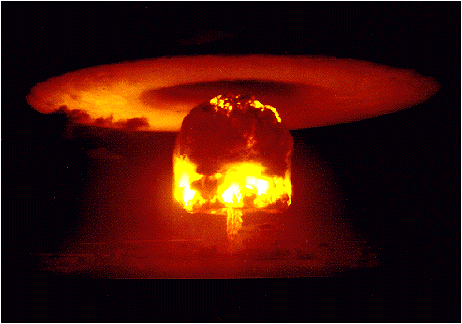The United States Drops Hydrogen Bomb On Bikini
Bikini is an island in the Pacific, part of the Marshall islands. The bomb dropped by the U.S. was believed to be 1,000 times more powerful than the bombs dropped on Hiroshima and Nagasaki. The blast was much more powerful than scientists had calculated, and was so violent the measuring instruments were overwhelmed. The bomb was as powerful as over one million tons of TNT.
The gigantic mushroom produced by the bomb covered over 100 miles wide and totally vaporized one of the Atolls, which disappeared. Large amounts of fall-out fell back into the ocean. The Atomic Energy Commission stated this bomb was the first in a series, with others to follow in that area.

Hydrogen Bomb-By USAF
One of the biggest worries the U.S. had was that the effect of radiation on the natives would be disastrous. Scientists calculated the area that would be in danger, and moved the natives to the island of Rongerik, eventually moving to two other islands, the last move being in 1949. Since the blast would be the largest ever man-made explosion so far, radiation poisoning of the natives was a real worry. A 23 man crew of the Japanese fishing boat "Fukuryu Maru" suffered radiation burns and contamination, even though the boat was 80 miles from the test zone at the time of the explosion. The results of their radiation sickness was severe. A total of 264 people were accidentally exposed to radiation due to the unexpected size of the explosion, which was considerably larger than expected.
The natives were granted $325,000 in return for their departure from the area, however in 1974, 20 years later, they were allowed to return. Their return was only temporary, as they had to be evacuated four years later when high levels on radioactivity was discovered there. Twenty three nuclear tests were carried out at Bikini between 1946 and 1958.
The bomb on Bikini was the second there, as a 10.4 megaton bomb was exploded previously in 1952 at Enewatak, west of Bikini. That bomb completely destroyed one island and left a crater 175 feet deep. The Enewatak bomb was also hundreds of times more powerful than the Hiroshima bomb. The Enewatak weapon gained even greater destructive power by using a procedure which forced together together nuclei of hydrogen as compared to splitting atomic nuclei.
In 1961 Russia exploded a 50 megaton bomb.
Researched in New York Times


